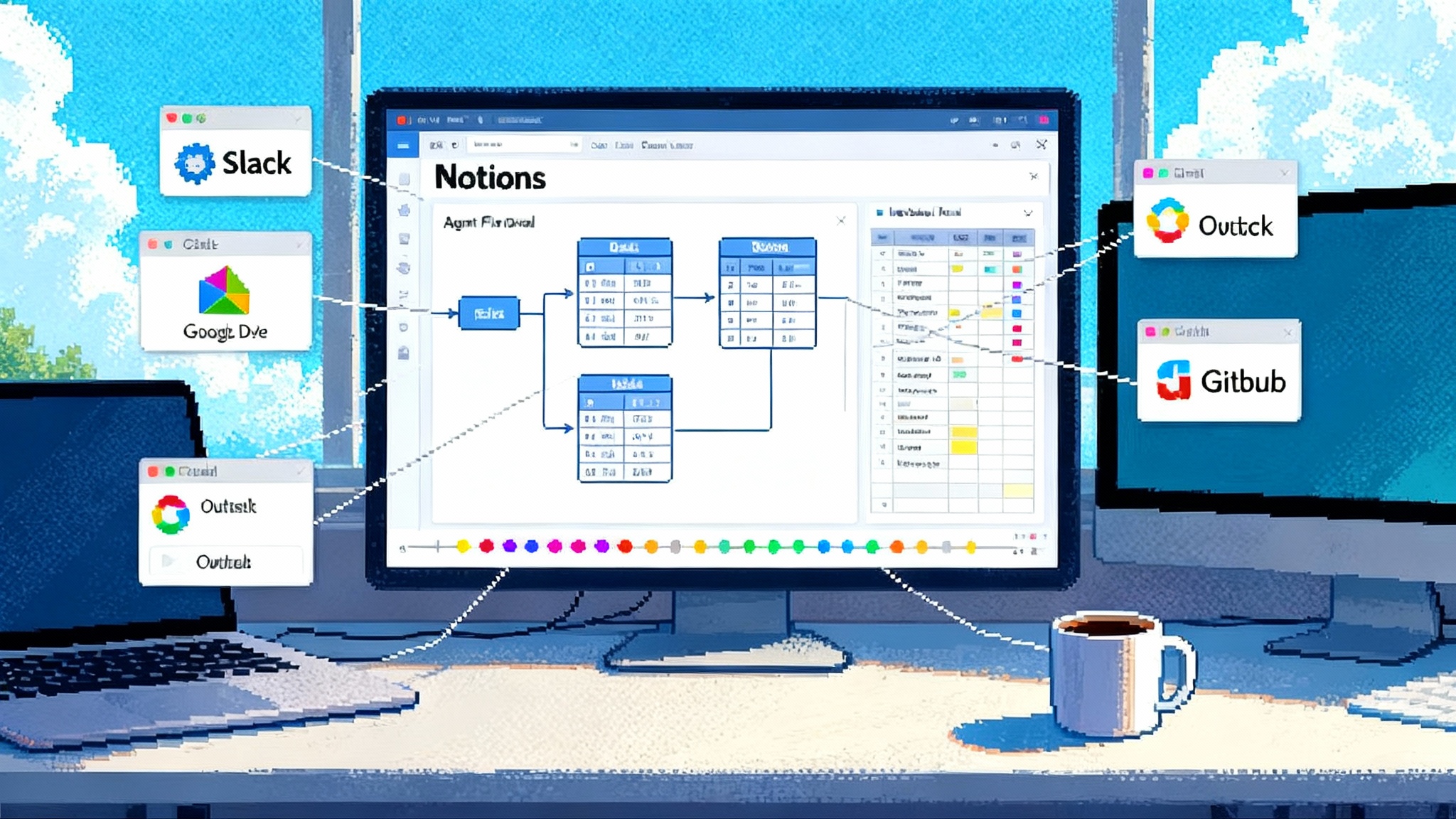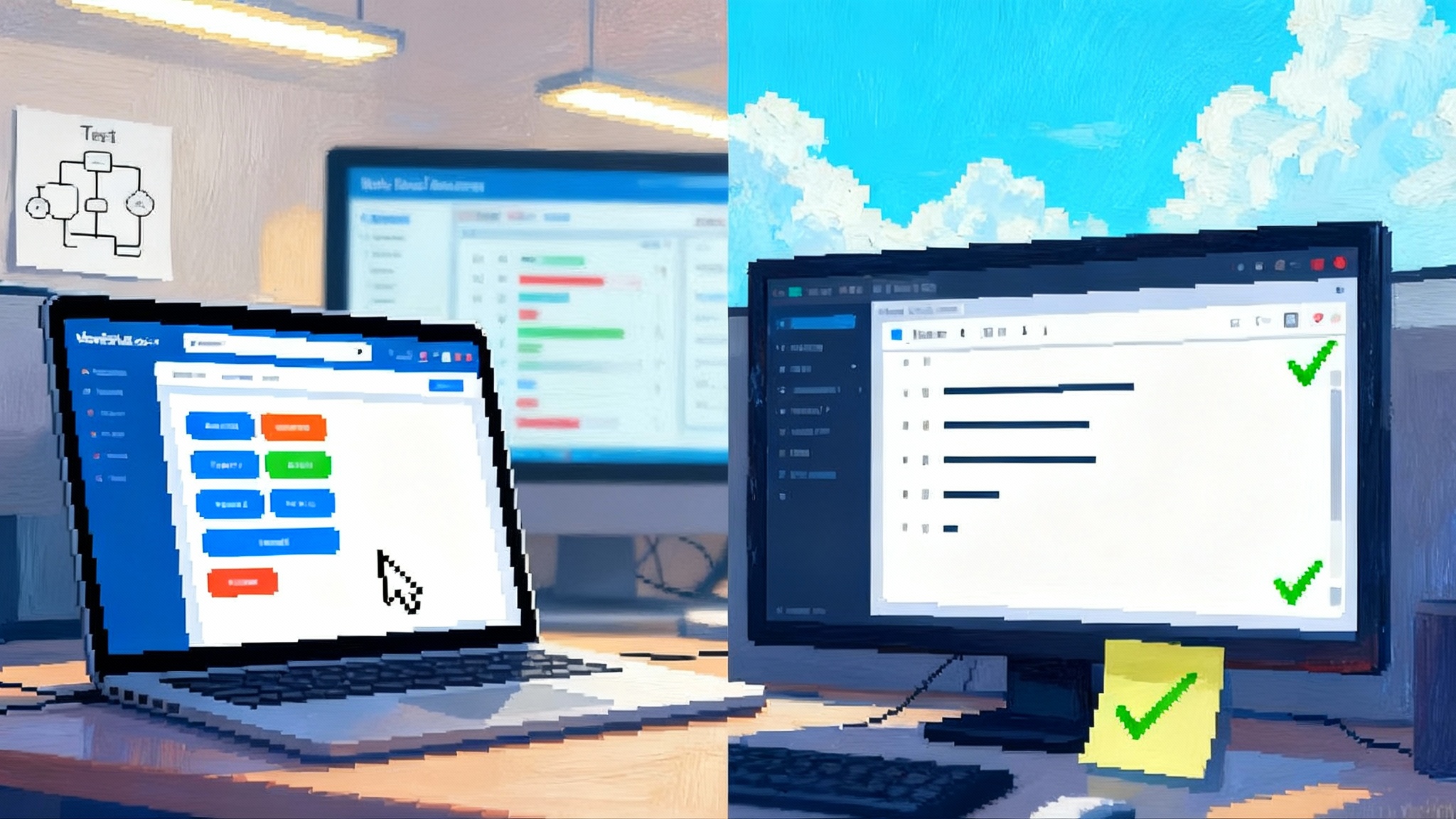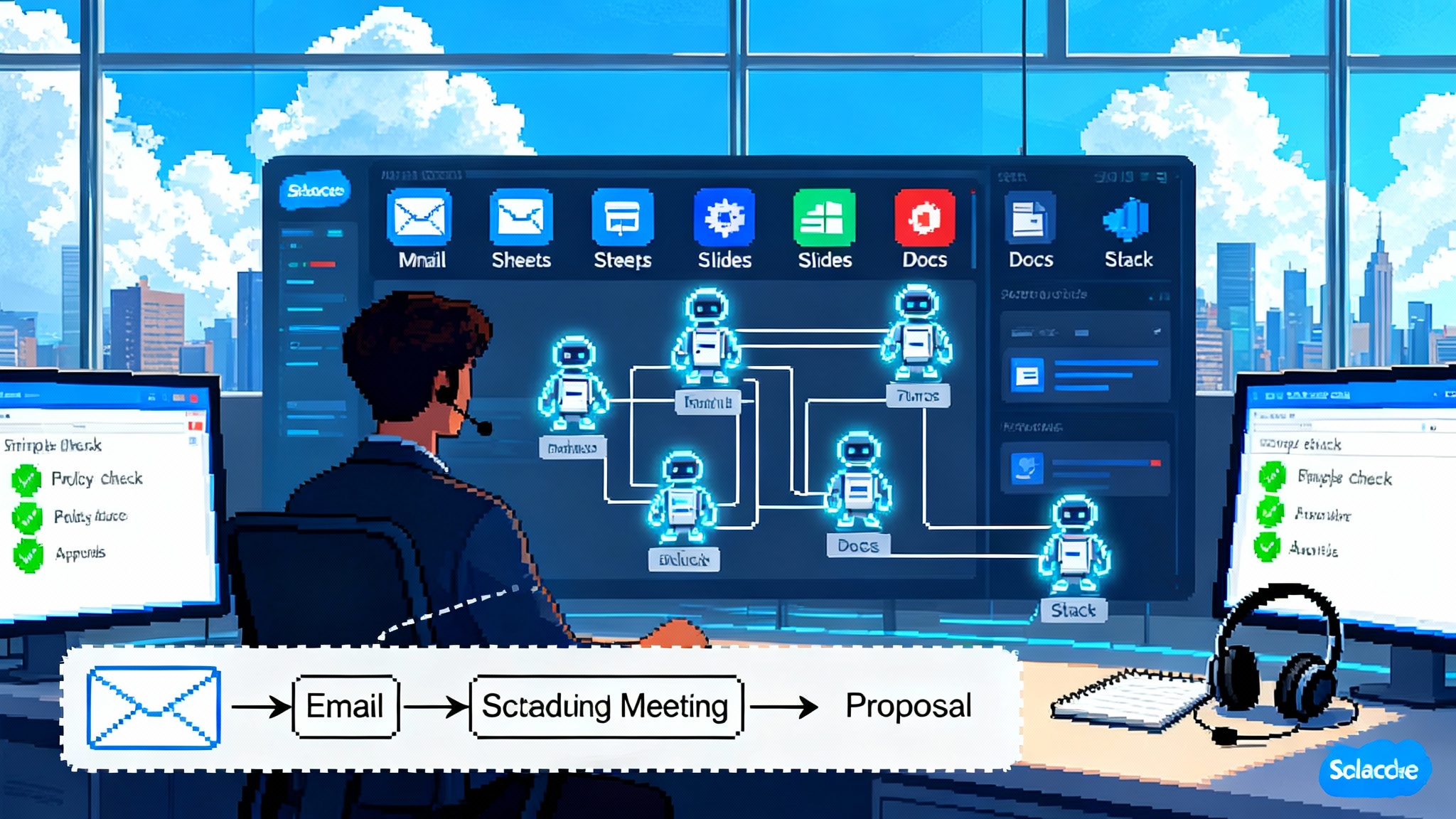Notion 3.0 Agents Turn Your Workspace Into the AI Runtime
Notion’s 3.0 Agents shift AI from sidecar chatbots to embedded coworkers that read, write, and act where your data already lives. Here is what changed, why it matters for Google, Microsoft, and Slack, and a pragmatic Q4 playbook to pilot it safely.

The week work software became an agent runtime
On September 18, 2025, Notion launched 3.0 Agents, reframing Notion from a smart editor into a place where software does work on your behalf. The company’s release notes describe agents that can carry out multi step tasks for more than 20 minutes, remember instructions as first class knowledge, and respond to triggers across your workspace. That is not a cosmetic upgrade. It is a blueprint for how productivity suites will operate. Notion 3.0 release notes.
The shift is easy to visualize. For the last two years, many teams treated artificial intelligence like a separate power tool in a shed behind the office. You walked outside, used it, and then carried the output back inside to your documents, tasks, and calendars. Agents inside Notion turn the office itself into the machine room. The work stays where the data, permissions, and relationships already live. For how standards are converging, see the open agent stack arrives.
From standalone stacks to embedded coworkers
The first generation of enterprise artificial intelligence emphasized model choice and infrastructure. Teams compared providers, debated context windows, and assembled stacks with vector databases, retrieval libraries, and orchestration layers. That was useful for proofs of concept, but it created an adoption tax. Every workflow required a bridge between the agent and the place where the work actually happened. Bridges add friction and risk.
Embedded agents invert the pattern. Instead of asking people to leave their workspace, the agent shows up where they already work. It runs next to the identity system, inherits permissions, sees the same documents your team is already collaborating on, and reacts to events that the workspace emits in real time. The effect is like moving from a universal remote to a cockpit. You are no longer translating a request across rooms. You are pressing a control that is wired directly into the system.
There are three practical reasons this matters now:
- Proximity to data and identity. The best agent responses come from the documents, tables, and messages you already maintain. An agent that lives in the workspace can read and write with the same access you granted to your teammates.
- Eventful surfaces. Workspaces generate constant, useful signals. A deal moved to commit. A pull request merged. A comment resolved. Agents tied to these events act at the moment value changes.
- Lower setup cost. You do not need to stand up separate storage or replicated permissions. You give the agent an instructions page, point it at databases, and connect a few tools.
What Notion 3.0 Agents actually add
The release puts three capabilities on the table that preview where suites like Google Workspace, Microsoft 365, and Slack will go next.
- Long running actions
The common frustration with chat style assistants is that they stop too soon. A human teammate would not halt after a single draft. They would create the draft, file the task, set a reminder, and notify the channel. Notion agents can run for extended periods, performing chained actions across many pages and databases. That means they can do work that previously required a person to babysit a script. Think of this as scheduled, resilient automation with a front end you already use. For a broader context on orchestration, see orchestration is the new battleground.
Concrete example: a launch agent that reads a product spec, creates a six week checklist, assigns owners, writes a newsletter draft for marketing, files an issue in your bug queue if the test plan misses coverage, and posts an update in the project channel every Monday at 9 a.m.
- First class memory
Most assistants accept prompts. Notion agents accept living instructions. You write an instructions page that specifies style, preferred sources, and filing rules. The agent remembers and improves over time, like a colleague who learns your shorthand and folder structure. Because memory lives as pages and databases, you can review and edit it with the same controls you already use. This is important for governance. Memory that is visible and versioned can be audited.
- Cross app triggers inside the workspace
Notion agents can react to events inside Notion and from connected tools. That looks like an automation platform, but with the added benefit that your documents, tasks, and instructions are all in the same canvas. When a status changes in a database, the agent acts. When a key email arrives in your company mailbox, the agent files a summary and creates a follow up. When a new customer feedback thread hits a threshold, the agent opens a research doc and assigns interviews. The triggers are the nervous system of the workspace.
Two additional features round out the picture. Row level permissions mean you can place an agent on a database without revealing every record to every person. Connectors pull context from mail, storage, and code tools and let the agent write back into your canonical pages. If your team already centralizes context in Notion, the agent does not need to ferry copies around. It works in the source of truth.
Why this previews a broader pivot across suites
The center of gravity is moving toward agents that live where the work is. You can see it in the roadmaps of other major suites.
- Microsoft 365 is making Copilot agents more native to the suite. At Microsoft Build in May, the company introduced multi agent orchestration in Copilot Studio and highlighted how teams can bring their own models. The direction is clear. Agents will coordinate with each other and run in the same surfaces where people write, meet, and plan. Multi agent orchestration in Copilot Studio.
- Slack continues to evolve from a chat stream into an automation plane. Workflow Builder with artificial intelligence steps generates flows from plain language prompts, and agents can summarize channels, turn messages into tasks, and tie into calendars. Slack is teaching teams to describe outcomes in chat and let the platform do the wiring.
- Google Workspace has been steadily weaving Gemini into Docs, Sheets, Gmail, and Drive. The important pattern is not the sidebar. It is that suggested actions and summaries are turning into triggers and routines. When an attachment looks like a contract, the suite can nudge an agent to file it, request a signature, and notify procurement.
Across these suites, the value will not be a fancy chat window. It will be the ability to place a durable agent into a team’s day to day environment with the same controls that already govern documents, calendars, and users. For how skills are becoming modular, see Claude Agent Skills signal modularity.
Design principles for workspace native agents
As your organization evaluates this wave, look for six design principles in the platforms and pilots you adopt.
- Memory lives as content
If instructions and preferences are editable content, not black box configuration, you gain explainability and control. People can review what the agent knows, propose changes, and track revisions like any other document.
- Long actions with graceful recovery
Agents should be able to do work that takes time, including retries and checkpoints. They should expose progress, provide a transcript of what they did, and resume from the last good step if interrupted.
- Events drive behavior
The best agents react to changes in the workspace. A new hire starts. A contract moves to signature. A build fails. Event driven agents reduce polling, eliminate stale tasks, and act at the right moment.
- Permission inheritance and least privilege
Agents should inherit user or service identities and only see what they need. Database row permissions and granular scopes are not optional. They are the guardrails that make autonomy safe.
- Observability your operations team can use
Logs, metrics, and analytics must live where your operations team already monitors systems. That means clear dashboards for run counts, error classes, time saved, escalation rates, and the ability to drill into specific runs without exposing sensitive content.
- Composability without chaos
Agents should use standard actions in your suite, not one off scripts. The more an agent’s steps look like normal edits, comments, and assignments, the easier it is to review and to hand off between agents or humans.
A pragmatic Q4 2025 playbook
You can pilot workspace native agents this quarter without betting the company. Here is a step by step playbook that balances speed with safety.
Step 1: Choose two business outcomes, not ten
Pick one customer facing workflow and one internal workflow where the agent can both read and write. Examples:
- Customer facing: triage and respond to inbound product feedback, tag themes, create follow ups, and post a weekly summary.
- Internal: weekly account health reviews that collect signals from support, product usage, and sales notes, then propose actions to owners.
Define the finish line. For each workflow, write a pinned statement like this: success means the agent produces a weekly summary on time, assigns follow ups with owners and due dates, and escalates ambiguities to a human within two hours.
Step 2: Prepare the workspace
- Create or clean up the databases the agent will use. Add clear properties for status, owner, priority, and dates.
- Turn on row level permissions where sensitive records exist. Test with a non admin account.
- Connect only the sources you need first. Mail, storage, and code repositories are common. Expand later.
Step 3: Author the agent’s instructions as a living page
Write an instructions page that contains:
- The task definition and how to decide if it is done
- Style and tone guidelines with one or two short examples
- The sources it can trust and those it should not use
- Filing rules for where to create tasks and drafts
- The escalation matrix with names, channels, and time limits
Keep this short and explicit. Treat the page like a team playbook. Review it weekly based on what the agent did.
Step 4: Wire up triggers and schedules
- Start with a schedule that runs at a predictable time to build confidence.
- Add event triggers once the schedule is stable. For example, when new feedback is labeled critical, or when a deal moves to a late stage.
- Ensure every trigger has a clear off switch and a channel for alerts.
Step 5: Bake in guardrails
- Identity and scopes. Use a dedicated service identity for agents where available. Grant the least access that still lets them work.
- Confirmation gates. For high impact edits, ask the agent to propose changes for a human to approve during the pilot phase.
- Dry runs. For the first week, have the agent write proposed actions to a log or draft space instead of making live edits.
Step 6: Measure what matters from day one
- Cycle time. Time from event to action. Agents should shorten the loop by hours, not seconds.
- Human confirmation rate. Percentage of actions a human approves without changes. Improves as memory and instructions get better.
- Escalation rate and reasons. Spot where ambiguity or missing context forces the agent to stop.
- Quality proxy. For content tasks, track reading time, click through, or peer review scores. For operational tasks, track reopen rate or defect escapes.
- Time saved. Have owners estimate minutes saved per run and multiply by run count. This is imperfect, but it grounds your conversation in value.
Step 7: Close the loop with weekly reviews
- Review the agent’s run log with the team. Praise what worked. Fix the instructions where it did not.
- Retire steps that add little value. Add one new capability per week so the agent gets better without surprising anyone.
- Decide what to graduate from pilot to production, and what to pause.
Operating model and governance that scale
A pilot succeeds when the first week without you goes smoothly. To reach that point, assign clear accountability.
- Product owner. Owns the outcome and the instructions page. Decides what good looks like.
- Builder. Configures the agent and connectors. Often the same person as the product owner at the start.
- Reviewer. A designated human who approves high impact changes and handles escalations during the pilot.
- Security partner. Reviews scopes and audit logs, and defines incident response.
Create a simple register of agents with columns for owner, purpose, scopes, triggers, and current status. Post it in a shared place. For every new agent, require a one page design brief that anyone can read and challenge.
For risk management, focus on four controls:
- Scope hygiene. Review every connected source quarterly. Remove access the agent no longer uses.
- Data boundaries. Keep sensitive records in separate databases with row level permissions and strict triggers.
- Kill switch. One button or command that stops an agent immediately and leaves a trace.
- Audit trail. Every run should leave a human readable summary of steps taken and objects touched.
What to expect from other suites in the next cycles
Expect three visible changes across Google Workspace, Microsoft 365, and Slack.
- Agents will coordinate with each other. Not just one helper per team, but a small cast that hands off tasks. Microsoft’s multi agent orchestration is an early sign.
- Bring your own model will be normal. Suites will let you choose a model per agent or per task, then apply the same governance and analytics you use for the rest of the platform.
- Triggers will get richer. Calendar events, document states, and security signals will all be first class hooks, not just message keywords or file saves.
The competitive advantage will come from how deeply each suite integrates agents with permissions, analytics, and admin controls. The teams that move fastest will be those that already have clean data, consistent naming, and clear ownership.
A quick checklist for your Q4 pilot
- Two use cases with measurable outcomes
- Clean databases with owners and row level permissions
- One instructions page per agent, treated like a living document
- Minimal necessary connectors to start
- Schedule first, then event triggers
- Guardrails: scopes, confirmation gates, dry runs, kill switch
- Weekly reviews with metrics that matter
If you cannot check a box, pause and fix that condition before you add more capability. Speed without clarity is a false win.
The bottom line
Notion’s Agents do not just add a new button. They shift the center of gravity from standalone stacks to embedded coworkers that act where the work and data already live. Microsoft, Google, and Slack are converging on the same pattern. The right response is not to rebuild your stack from scratch. It is to move a small, real workflow into this new model, learn quickly, and scale what works. As you do, keep an eye on how standards and skills evolve in adjacent ecosystems like the open agent stack arrives and Claude Agent Skills signal modularity.
The office just became the runtime. Treat your workspace like an operating system. Put each agent on a clear job, give it memory you can edit, and connect it to the events that matter. By the end of this quarter, you can have agents that draft, file, assign, and report without leaving the tools your team already uses. That is the best kind of transformation. It feels less like a revolution and more like your day finally clicking into place.








